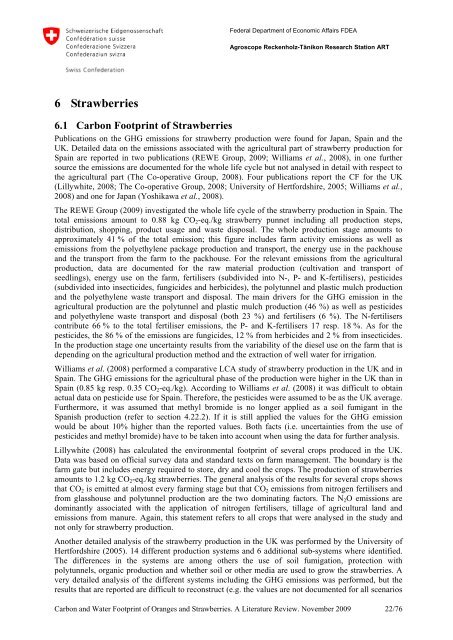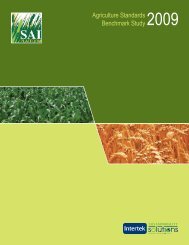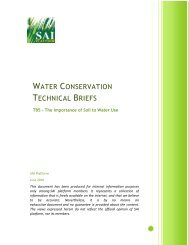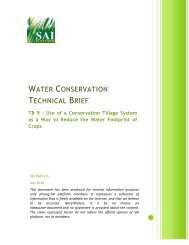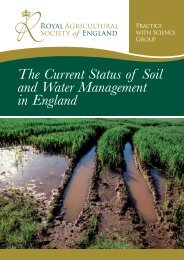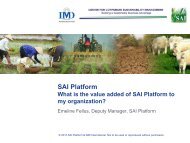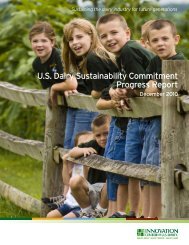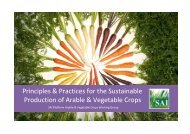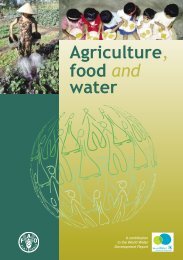Carbon & Water Footprint of Oranges and Strawberries - SAI Platform
Carbon & Water Footprint of Oranges and Strawberries - SAI Platform
Carbon & Water Footprint of Oranges and Strawberries - SAI Platform
Create successful ePaper yourself
Turn your PDF publications into a flip-book with our unique Google optimized e-Paper software.
Federal Department <strong>of</strong> Economic Affairs FDEA<br />
Agroscope Reckenholz-Tänikon Research Station AR T<br />
6 <strong>Strawberries</strong><br />
6.1 <strong>Carbon</strong> <strong>Footprint</strong> <strong>of</strong> <strong>Strawberries</strong><br />
Publications on the GHG emissions for strawberry production were found for Japan, Spain <strong>and</strong> the<br />
UK. Detailed data on the emissions associated with the agricultural part <strong>of</strong> strawberry production for<br />
Spain are reported in two publications (REWE Group, 2009; Williams et al., 2008), in one further<br />
source the emissions are documented for the whole life cycle but not analysed in detail with respect to<br />
the agricultural part (The Co-operative Group, 2008). Four publications report the CF for the UK<br />
(Lillywhite, 2008; The Co-operative Group, 2008; University <strong>of</strong> Hertfordshire, 2005; Williams et al.,<br />
2008) <strong>and</strong> one for Japan (Yoshikawa et al., 2008).<br />
The REWE Group (2009) investigated the whole life cycle <strong>of</strong> the strawberry production in Spain. The<br />
total emissions amount to 0.88 kg CO 2 -eq./kg strawberry punnet including all production steps,<br />
distribution, shopping, product usage <strong>and</strong> waste disposal. The whole production stage amounts to<br />
approximately 41 % <strong>of</strong> the total emission; this figure includes farm activity emissions as well as<br />
emissions from the polyethylene package production <strong>and</strong> transport, the energy use in the packhouse<br />
<strong>and</strong> the transport from the farm to the packhouse. For the relevant emissions from the agricultural<br />
production, data are documented for the raw material production (cultivation <strong>and</strong> transport <strong>of</strong><br />
seedlings), energy use on the farm, fertilisers (subdivided into N-, P- <strong>and</strong> K-fertilisers), pesticides<br />
(subdivided into insecticides, fungicides <strong>and</strong> herbicides), the polytunnel <strong>and</strong> plastic mulch production<br />
<strong>and</strong> the polyethylene waste transport <strong>and</strong> disposal. The main drivers for the GHG emission in the<br />
agricultural production are the polytunnel <strong>and</strong> plastic mulch production (46 %) as well as pesticides<br />
<strong>and</strong> polyethylene waste transport <strong>and</strong> disposal (both 23 %) <strong>and</strong> fertilisers (6 %). The N-fertilisers<br />
contribute 66 % to the total fertiliser emissions, the P- <strong>and</strong> K-fertilisers 17 resp. 18 %. As for the<br />
pesticides, the 86 % <strong>of</strong> the emissions are fungicides, 12 % from herbicides <strong>and</strong> 2 % from insecticides.<br />
In the production stage one uncertainty results from the variability <strong>of</strong> the diesel use on the farm that is<br />
depending on the agricultural production method <strong>and</strong> the extraction <strong>of</strong> well water for irrigation.<br />
Williams et al. (2008) performed a comparative LCA study <strong>of</strong> strawberry production in the UK <strong>and</strong> in<br />
Spain. The GHG emissions for the agricultural phase <strong>of</strong> the production were higher in the UK than in<br />
Spain (0.85 kg resp. 0.35 CO 2 -eq./kg). According to Williams et al. (2008) it was difficult to obtain<br />
actual data on pesticide use for Spain. Therefore, the pesticides were assumed to be as the UK average.<br />
Furthermore, it was assumed that methyl bromide is no longer applied as a soil fumigant in the<br />
Spanish production (refer to section 4.22.2). If it is still applied the values for the GHG emission<br />
would be about 10% higher than the reported values. Both facts (i.e. uncertainties from the use <strong>of</strong><br />
pesticides <strong>and</strong> methyl bromide) have to be taken into account when using the data for further analysis.<br />
Lillywhite (2008) has calculated the environmental footprint <strong>of</strong> several crops produced in the UK.<br />
Data was based on <strong>of</strong>ficial survey data <strong>and</strong> st<strong>and</strong>ard texts on farm management. The boundary is the<br />
farm gate but includes energy required to store, dry <strong>and</strong> cool the crops. The production <strong>of</strong> strawberries<br />
amounts to 1.2 kg CO 2 -eq./kg strawberries. The general analysis <strong>of</strong> the results for several crops shows<br />
that CO 2 is emitted at almost every farming stage but that CO 2 emissions from nitrogen fertilisers <strong>and</strong><br />
from glasshouse <strong>and</strong> polytunnel production are the two dominating factors. The N 2 O emissions are<br />
dominantly associated with the application <strong>of</strong> nitrogen fertilisers, tillage <strong>of</strong> agricultural l<strong>and</strong> <strong>and</strong><br />
emissions from manure. Again, this statement refers to all crops that were analysed in the study <strong>and</strong><br />
not only for strawberry production.<br />
Another detailed analysis <strong>of</strong> the strawberry production in the UK was performed by the University <strong>of</strong><br />
Hertfordshire (2005). 14 different production systems <strong>and</strong> 6 additional sub-systems where identified.<br />
The differences in the systems are among others the use <strong>of</strong> soil fumigation, protection with<br />
polytunnels, organic production <strong>and</strong> whether soil or other media are used to grow the strawberries. A<br />
very detailed analysis <strong>of</strong> the different systems including the GHG emissions was performed, but the<br />
results that are reported are difficult to reconstruct (e.g. the values are not documented for all scenarios<br />
<strong>Carbon</strong> <strong>and</strong> <strong>Water</strong> <strong>Footprint</strong> <strong>of</strong> <strong>Oranges</strong> <strong>and</strong> <strong>Strawberries</strong>. A Literature Review. November 2009 22/76


